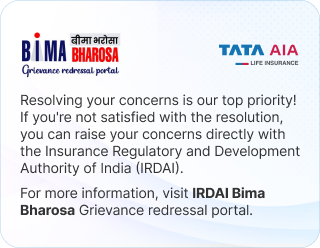Goods and Services Tax (GST) on life insurance is a key cost factor for policyholders. An endowment policy, which offers both insurance protection and savings included GST charges on premiums. The government has revised this, with effect from 22 September 2025. The new tax regime exempts GST on endowment policies, reducing premium rates for individuals. This blog explains everything you need to know about GST on endowment policy according to the new tax regime.
What is GST (Goods and Services Tax)?
GST is an indirect tax system that was introduced in India on July 1, 2017, to simplify the country's complicated tax system. Businesses and consumers had to deal with multiple taxes before GST, including service tax, Value Added Tax (VAT), central excise duty, and sales tax. As a result, the tax structure was unclear and inconsistent across states. Having combined all these taxes, GST simplifies tax management for businesses, consumers, and the government.
What is GST on Endowment Policy?
GST on an Endowment Policy is the Goods and Services Tax applied to the premiums paid for the policy. An endowment policy combines life insurance coverage with a savings component. Effective from 22 September 2025, GST on all individual policies, including endowment policy is reduced to zero to make insurance affordable for the common man. This tax is collected by the insurance company and paid to the government. The GST rate may vary depending on the type of policy and the premium amount, as per the existing tax regulations.
Old GST Rates on Endowment Policies
Premiums of endowment policies were previously subject to an 18% GST. After GST deduction, only the remaining amount was allocated to savings and life insurance component. As a result, policyholders were subject to higher premium costs. In comparison to the new revised structure, these life insurance-cum-savings plans were relatively more expensive.
New GST Rates on Endowment Policies
From September 22, 2025, the GST on individual life insurance policies has been removed.
- Effective Date: The GST exemption applies to policies purchased or renewed on or after September 22, 2025.
- New Rate: The GST rate is now 0% on individual endowment policies, making premiums exempt from GST.
- Scope of Change: The exemption covers individual term insurance, ULIP, and endowment policies. Group life insurance policies will continue to have 18% GST.
This change ensures that new and renewed individual endowment policies will not carry any GST charges under the new regime.
Difference between Old and New GST Rates
The following table highlights the differences between the old and new GST rates on endowment policies.
Policy Type |
Old GST Rate |
New GST Rate (From Sep 22, 2025) |
Endowment 1st Year |
4.5% |
0% |
Endowment Renewal |
2.25% |
0% |
Impact on Policyholders
The exemption of GST on endowment policies has the following impact on the policyholders:
- Lower Premiums: The removal of GST reduces the total premium payable, resulting in lower costs for policyholders.
- Renewal Benefits: Policies renewed after the effective date will be billed without GST, while premiums already paid before the date remain unchanged.
- No GST Refunds: GST paid on advance premiums before September 22, 2025, will not be refunded to policyholders.
Technical Considerations
The new tax rules bring certain technical aspects that both customers and insurers should understand.
- Input Tax Credit (ITC) Loss: Insurers will not be able to claim ITC on expenses like office rent, services, or agent commissions due to the GST exemption.
- Effect on Premiums: This loss of ITC may cause insurers to relook at the premiums they offer, but any hike, if at all, is still expected to be lower compared to the earlier premium with 18% GST.
- Access to Insurance: The exemption aims to increase access to insurance products in the country, by making policies easy to afford for individuals.
Conclusion
The GST exemption on endowment policies under the new tax rates changes the premium calculation structure. The removal of GST from individual life policies such as endowment plans reduces premium for policyholders and improves accessibility of insurance. While insurers lose certain tax credits, individuals still benefit from lower premiums compared to the earlier structure.











 FOR EXISTING POLICY
FOR EXISTING POLICY 
 FOR NEW POLICY
FOR NEW POLICY 








